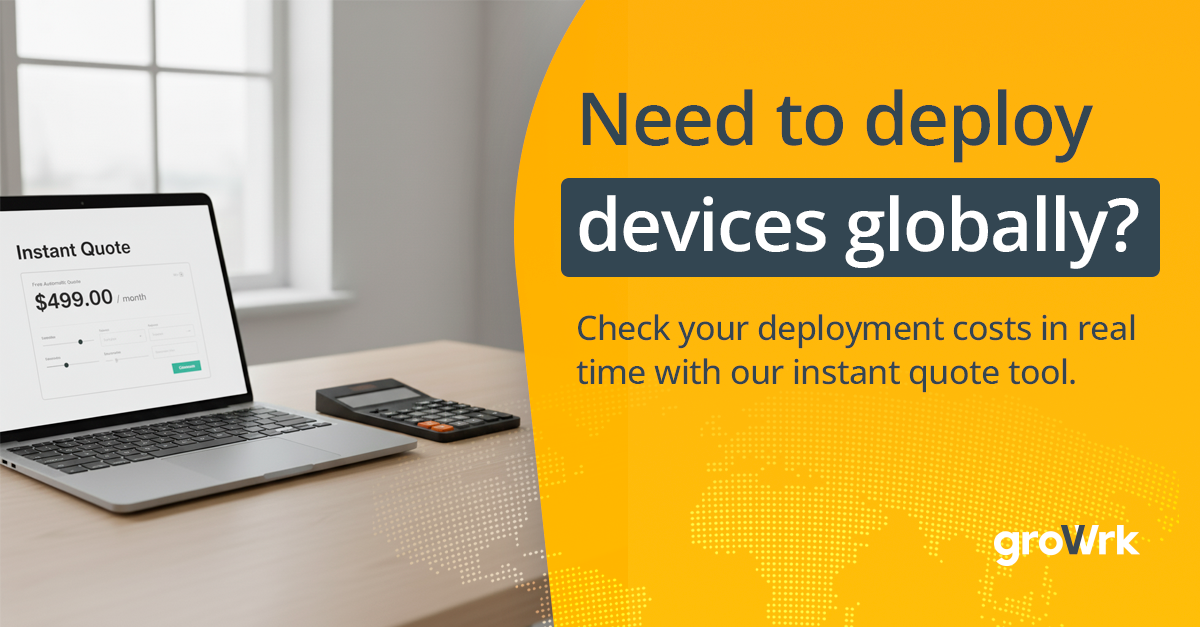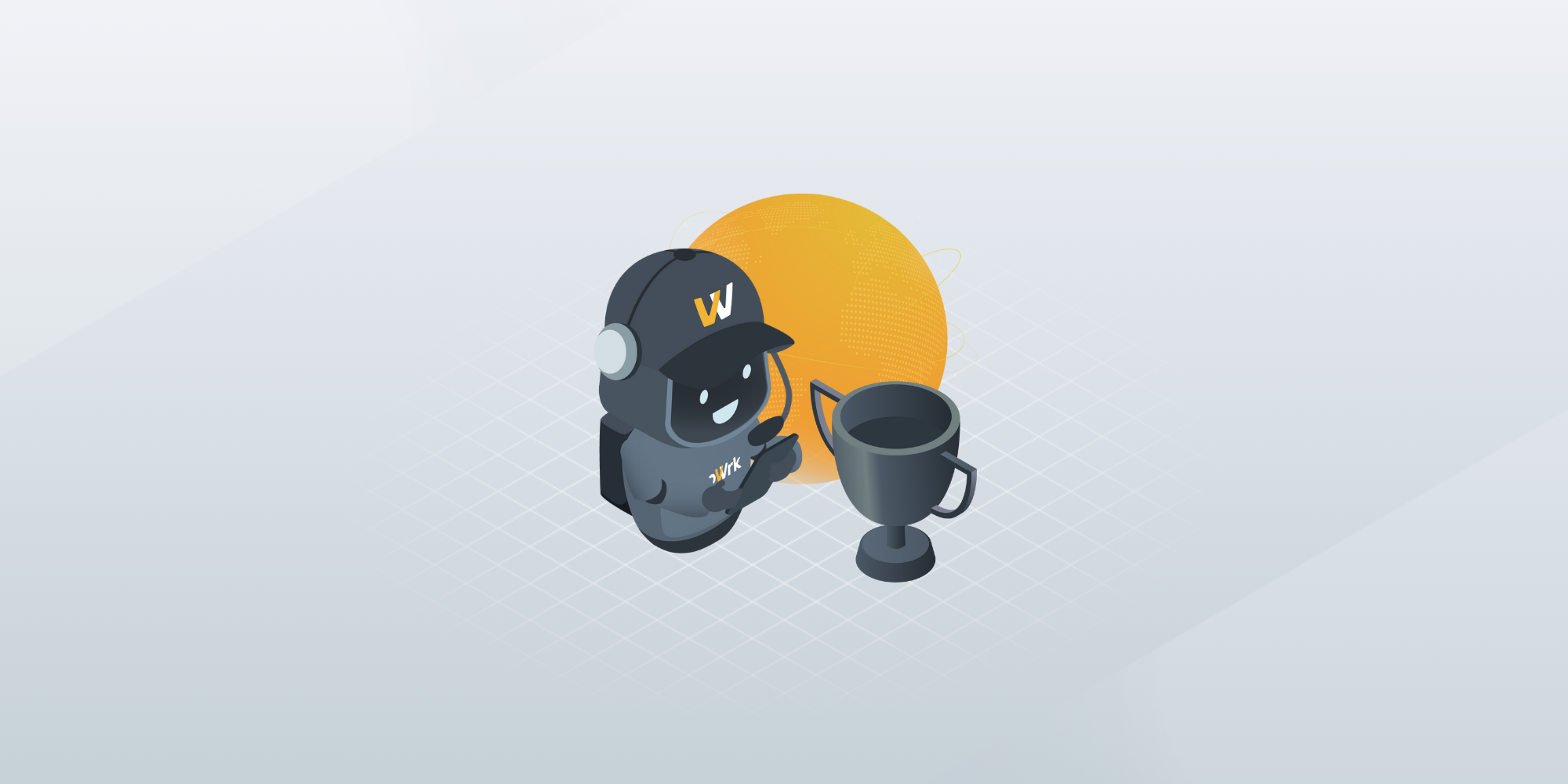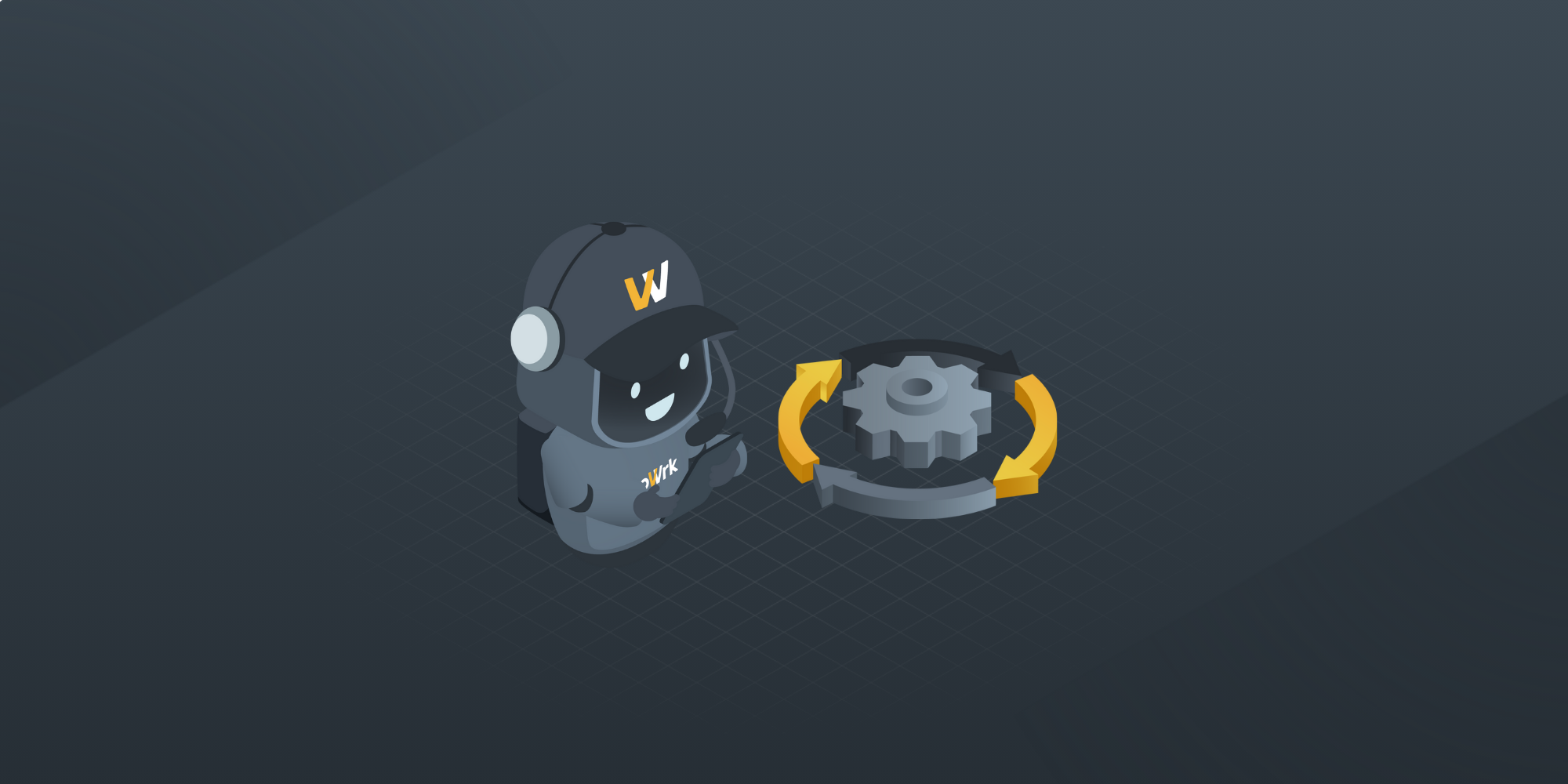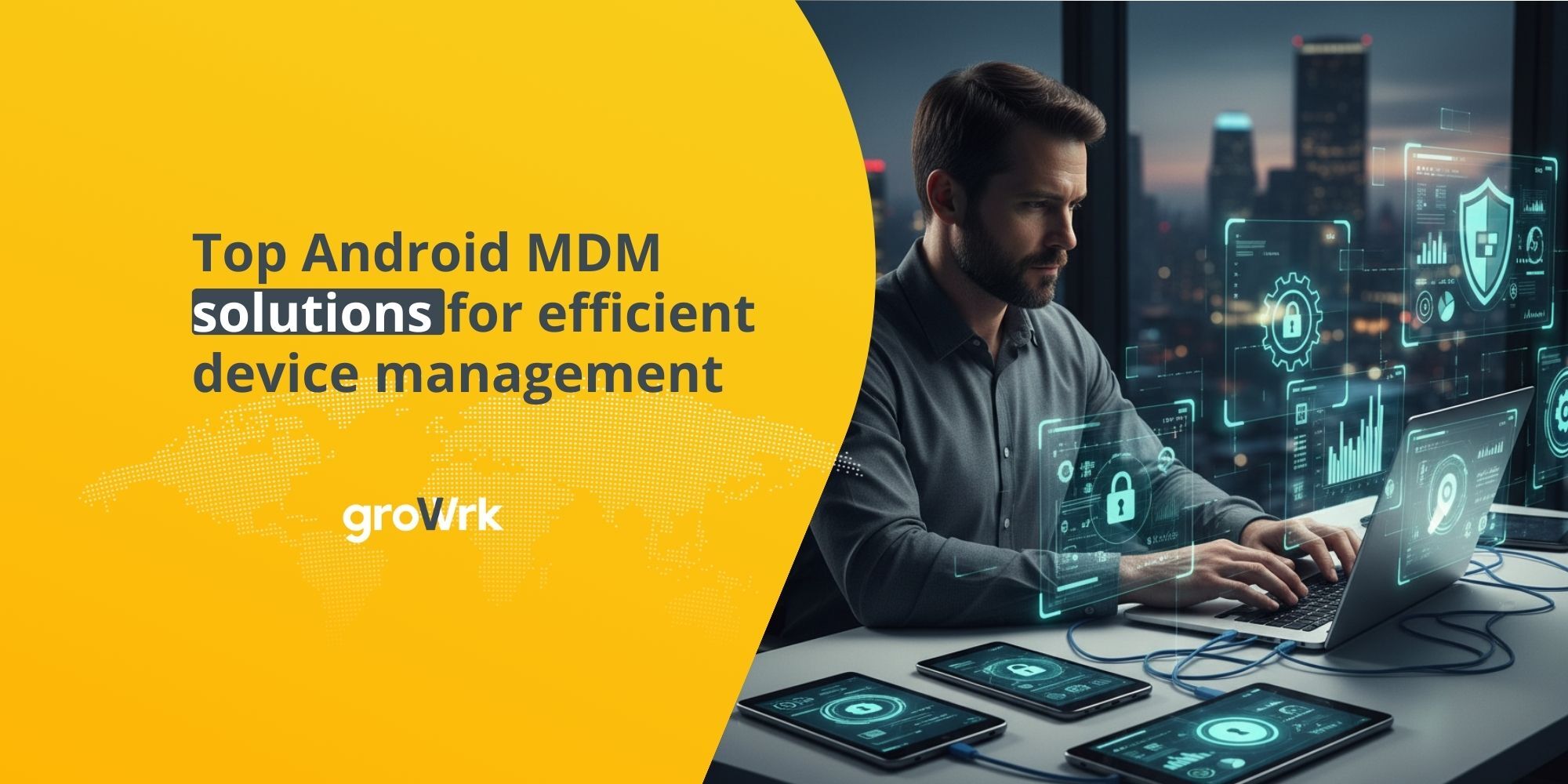Global IT Procurement: Key Challenges & Trends for 2025
 Zachary Trudeau
Zachary Trudeau
A reliable IT procurement process is essential to growth and success in today’s corporate climate. Considering your organization’s technology and budget needs, are you getting the best products for the lowest prices? Do you have a consistent supply of devices to deploy to new hires anywhere in the world immediately? Are you able to ensure across-the-board compliance with company policy for each purchase?
Modern problems require modern solutions. Fortunately, the IT procurement strategy you need is at your fingertips, thanks to GroWrk. Understanding the procurement process and its best practices for the modern global workforce will allow your business to fully reap the benefits of distributed teams and scale your operations anywhere. Let's take a look at what global IT procurement entails in 2025.
What is IT procurement?
IT procurement is not just one thing but a set of processes that work together to evaluate, acquire, and manage your organization’s IT resources. How do you know which purchases to make? Identifying the technology needs within your organization is the first step and the answer to that question.
Once you’ve determined your needs, you must conduct market research to find the products and services that address them. Next, you must find vendors and negotiate contracts. Maintaining vendor relationships is necessary to secure consistent supplies and lower prices. Employ IT vendor management best practices to streamline your vendor experience.

Five stages of global IT procurement
- Research: Identify operational activities, market and customer needs, and competitors. Define your company’s target markets, objectives, and positioning.
- Supplier and market evaluation: Set the criteria for selecting suppliers based on the research. Analyze the market for potential vendors.
- Sourcing event: Choose the supplier that meets your company’s criteria. Conduct a thorough evaluation to ensure the chosen supplier meets all requirements.
- Implementation: Once a supplier is chosen, your company should develop an implementation plan. The procurement team manages this process to ensure alignment to company strategy.
- Performance monitoring: After implementation, your company must monitor the supplier’s performance to ensure they meet expectations and quality. Perform regular checks to optimize the ongoing processes.
Since you’re buying for a business, you must abide by a set of purchasing standards. A solid vendor relationship is vital for building trust and transparency, but it also requires much effort – especially if you need several vendors to supply laptops to multiple continents.
Get an instant quote
Importance of global IT procurement
Businesses that operate internationally must rely on diverse global vendors to ensure their workers are equipped and working securely.
Selecting a vendor is often the most challenging aspect of IT procurement. With the rise of a globally distributed workforce, the challenge has increased as each region of operation requires its own vendor. That means each time you onboard a new hire in Brazil or Bulgaria, you need a vendor in their area to equip them with the tools they need to get off to a running start.
However, this selection process must take many factors into account. For example, each vendor you decide to work with must also meet your company’s requirements for quality and security, while operating within their own local laws and logistics.
Consider the goals and challenges of modern business. You have a distributed workforce because you want the best talent available. For their productivity and company security, you must ensure each team member is equipped with an MDM-enrolled device. All of this must be accomplished at the lowest possible cost.

Global procurement is driven by logistics and cost savings. Finding the balance between these is needed to acquire the highest quality of resources while staying within budget constraints. Discover how end-to-end procurement services can simplify this process. Competitive markets offer the flexibility to source from different regions; that way, you can reduce costs without compromising efficiency or security.
Globalization has accelerated business growth worldwide but also requires rethinking traditional procurement practices. An effective international procurement process ensures seamless global operations. What worked in the past doesn’t work in the present, and as IT becomes more interconnected while the world gets smaller, IT procurement will continue to evolve.
This has led to the digital transformation of IT procurement practices. With applications and systems to collect, store, and manage IT equipment, global procurement processes can be automated and information centralized. This digitization enables an optimized workflow based on data and analytics to modernize IT procurement.
Challenges in global IT procurement in 2025

Complexity of the global supply chain
In the wake of globalization, the procurement function faces more complexities in supply chain management across diverse market trends. There is unpredictability in resource supply, regulations and taxes on certain goods across different regions, and new data privacy laws. This requires detailed supply chain planning and supplier management to avoid supply chain disruptions.
Despite the benefits of supplier diversity, the global supply chain processes become more challenging. Contract management, communication, and logistics create complex supply chains as suppliers have varying capabilities and quality standards – perhaps a supplier is subjected to regulations from a different region, and you must increase your audits or find other supply chain solutions.
Compliance and regulatory issues
Complying with regulations affects your organization’s risk factors and reputation. Therefore, compliance with environmental initiatives, labor laws, and safety standards is mandatory for reaching operational objectives. Failure to comply with all required regulations can result in financial penalties or a damaged reputation.
Compliance also plays a critical role in reducing data security risks. Adhering to data protection laws helps your company avoid costly penalties and data breaches. With a reliance on centralized systems and cloud-based resources for everyday operations, protecting data is the first priority in safeguarding your company’s assets from unauthorized access.
Cost management and budget constraints
Finding the balance between quality, cost, and procurement timelines can be challenging, but with the proper spend management, you can find success. First, you must clearly define your goals and expectations with a way to measure them. Next, you must carefully choose a supplier according to selective criteria and evaluate their performance and risk factors to see that your vision and values align.
Communicating with your suppliers is important to build trust and establish transparency. Monitoring their performance helps maintain standards and accountability, and ensures that service remains optimum. It’s essential to identify and mitigate risks throughout the entire supply chain, which requires working closely with your suppliers – so communication is key. Learn more about IT vendor management for consistent service quality.
The negotiation process can be complex and time-consuming as each region has separate pricing structures, legalities, and logistics. This may call for long discussions and compromises in order to align with your company’s budget and goals. Within the globalized market, currency fluctuations upend consistent pricing, which makes negotiating an ongoing process.
Technology integration and interoperability
Software integrations can optimize resources in the procurement process, but this requires interoperability between each piece of technology. Leveraging the power of each system in your workflow offers more functionality and greater flexibility. However, these integrations require compatibility across multiple regions and systems, which opens up a need for standardization.
A lack of standardization carries several issues: devices cannot communicate with each other because of data formats, systems not using standard protocols may become vulnerable and create security risks, and productivity and innovation can be lost.
The IEEE (Institute of Electrical and Electronics Engineers) works with multiple groups to create standards with IoT devices. However, given the number of varying devices and protocols, you still need to conduct your own research and compatibility tests to ensure that they function within your IT environment.
Explore GroWrk's integration options for seamless IT asset management.
Best practices in global IT procurement
Centralized vs. decentralized procurement models
To employ the best practices in global IT procurement, evaluating the pros and cons of centralized and decentralized methods can help you understand which approach is best for your company. Developing a comprehensive procurement plan is critical for success. Consider where to emphasize your procurement. Are you making bulk purchases? Do you need quicker transactions with less bureaucracy?
In a centralized model, one entity approves and manages all company purchases. For example, if a team needs an app to improve analytics, they submit a request to an internal team, who reviews and approves it.
Some benefits of centralized procurement are better visibility of spend and budget. Purchasing teams can negotiate contracts for better pricing and support. Processes are standardised and produce consistent results.
A drawback of centralized procurement is that purchasing can be inflexible. There’s not enough time to make important decisions and high volume of requests can cause delays. Purchases need to be planned well in advance and there’s no margin for error.
In decentralized procurement, multiple teams manage purchases for each purchase. For example, each department has its own approval process.
The benefits of decentralized procurement are more flexibility in decision-making, no bureaucracy, and faster purchasing. Each department that manages purchasing has the knowledge required for its needs.
However, this approach has big disadvantages. There is no standard process, so ensuring budgets and spending are always in sync becomes difficult. This can be a problem for your IT teams, which rely on standard processes to meet security requirements.

GroWrk's case study with OfferUp demonstrates how the centralized procurement model produced positive results.
OfferUp wanted to expand into Latin America and hire contractors to diversify its workforce. To this end, they needed to equip each contractor with a laptop pre-enrolled into Apple Business Manager (ABM) and retrieve it when the contract ended.
Coordinating with vendors for each country of operation proved to be a logistical nightmare. A lot of production was lost to back-and-forth emails, delayed deliveries, and devices that were not compliant with the ABM enrollment.
When OfferUp tried a centralized solution using GroWrk’s procurement services, they could check all the boxes and get pre-configured devices delivered to each contractor at fair prices. OfferUp accelerated and improved its onboarding process for all hires regardless of location.
Enhancing supplier collaboration
Sometimes, businesses combine strengths, and supplier collaboration is an example. In a McKinsey survey, companies collaborating with their suppliers experienced higher growth, lower costs, and more profitability than their contemporaries.
To foster a successful collaboration, ensure that your objectives align. Communication at the early stages is crucial, and your suppliers must be involved early. See to it that applicable knowledge is shared; this transparency helps fortify trust and keeps the team centered around common objectives. Supplier relationships are give-and-take, where you support each other’s development in service and innovation.
To enhance this collaboration, supplier relationship management (SRM) tools are designed to lighten the workload of the procurement team. These tools can identify suppliers to find the best match for your needs and help determine each supplier's value and importance. SRM optimizes procurement and supply chain performance through improved communication and coordination with suppliers.
GroWrk can enhance your supplier collaboration by acting as a middleman between local suppliers and your company. GroWrk's IT procurement services manage all vendor relationships globally, allowing you to focus on other strategic business initiatives.
Sustainable procurement practices
A growing factor in the globalized business landscape is the environmental, governance, and social (ESG) performance for sustainability. This promotes corporate responsibility to minimize the environmental impact of your organization’s operations. In practice, this could be balancing social and environmental factors against economic factors.
Sustainability helps facilitate growth in the future by responsibly using the resources needed to succeed today. Its practices are attractive to customer preferences, which satisfies stakeholders. An organization’s ESG performance can be measured, which is more incentive to implement sustainable practices.

Lifecycle management is integral to sustainability, spanning procurement to disposal. Understanding the IT asset management process involves managing devices throughout their lifecycle to optimize usage and ensure they are disposed of according to data and environmental laws.
Managing each device's lifecycle can get messy and run compliance risks for distributed teams. Fortunately, GroWrk’s EOL services help you manage your devices to the end of their lifecycle. We offer buyback, destruction, donation, and recycling options that you can request directly in the GroWrk Dashboard.
Future trends in global IT procurement

Digital transformation and automation
Digital transformation has given rise to cutting-edge technology that increases efficiency. Automation has been instrumental in streamlining procurement workflows by eliminating the need for many manual tasks, saving time with fewer human errors. Using a platform to automate purchase orders can save time. Rather than working across multiple spreadsheets, software, and emails, you can automate workflows to perform manual tasks, which reduces errors and provides better visibility.
Now, with the rise of artificial intelligence, global procurement is also being shaped by its power. Resource-intensive tasks like customer support and managing vendor relationships are being done with AI. Chatbots are able to handle inquiries, track orders, and resolve issues around the clock. You can use AI analysis to assess a vendor’s performance and gain new strategic insights – and this is just the beginning of its capabilities.
Additionally, blockchain technology can be another breakthrough that transforms IT procurement. In practice, it provides an immutable record of a resource throughout the entire supply chain to verify ethical sourcing, compliance with environmental standards, and authenticity.
Learn more about how GroWrk is leveraging AI to transform device management.
The impact of geopolitical shifts
Geopolitical events can cause massive changes in procurement strategies at a moment’s notice. Economic sanctions and new trade agreements have a direct impact on sourcing and costs. They play a considerable role in vendor selection and supply chain logistics.
The spontaneity of geopolitical shifts requires flexibility and adaptability in your IT procurement strategy. The agility to respond rapidly to a global event can help ensure supply chain consistency during unpredictable times. It should be remembered that the economic opportunities facilitated by globalism are also vulnerable to geopolitical changes.
Focus on cybersecurity
Cybersecurity is a significant concern for every business in every phase of its operations. To protect data and reduce threats, you can expect an increased emphasis on cybersecurity and IT procurement. The larger the supply chain, the more vulnerabilities there are to exploit, increasing the chances of a data breach.
Best practices for securing procurement systems and protecting sensitive information include classifying data based on vulnerability, enabling strict access controls, using end-to-end encryption in communication, and eliminating unnecessary storage of sensitive data. Implementing these will eliminate many security threats, but it is important to keep current with cybersecurity trends in order to avoid threats.
Wrapping up
IT procurement is an ongoing process, and as technology progresses, it will require consistent adaptation. No finalized strategy will work from here on out; your organization must constantly evolve its procurement strategies to remain efficient and compliant in a fast-moving environment. Business is centered around growth, so embracing new technologies and leveraging them to achieve that growth is the responsibility of everyone working in IT.
Each day, the world becomes increasingly digital and more interconnected than the previous day. Shaping your global IT procurement strategy around that allows you to plan and prepare for the unknown. Remembering this and employing the best procurement practices will help keep your operations running efficiently amidst these continuous changes.
GroWrk helps your business stay efficient and compliant in today's fast-paced IT procurement environment. Our procurement services adapt to your company's needs while meeting compliance with regulations in different regions and traversing the complexity of the global supply chain. Learn more about our comprehensive IT asset management and procurement solutions so you can scale without borders. Talk to one of our experts today!
FAQs
What is global procurement?
Global procurement is the process of sourcing goods and services from international suppliers to optimize costs, enhance supplier diversity, and standardize operations across regions. In IT, this involves acquiring hardware, software, and services globally to support business needs.
What does IT procurement do?
IT procurement handles the purchase of technology products and services, ensuring they align with the organization’s strategy. This includes vendor management, contract negotiation, and maintaining the tech infrastructure to support operations efficiently.
What are the 4 pillars of global procurement?
People: Skilled professionals who manage procurement.
Process: Streamlined steps for sourcing, contracting, and delivery.
Technology: Tools to automate and track procurement.
Supply chain: Global network of suppliers ensuring timely delivery.
What is an example of global procurement?
A company sourcing IT hardware from Asia, cloud services from North America, and software from Europe to leverage global expertise and reduce costs.
Why is sustainable procurement important in global IT procurement?
Sustainable procurement reduces environmental impact, enhances social responsibility, and meets regulatory requirements. It helps businesses minimize risks, improve their reputation, and contribute to long-term environmental and social goals.







